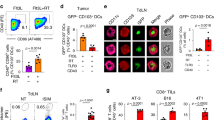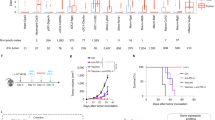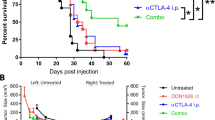Abstract
Local delivery of IL-12 and GM-CSF to advanced primary tumors results in T- and NK-cell-dependent cure of disseminated disease in a murine spontaneous lung metastasis model. Post-therapy functional dynamics of cytotoxic T- and NK-cells were analyzed in primary and metastatic tumors to determine the specific roles of each subset in tumor eradication. Time-dependent depletion of CD8+ T and NK-cells demonstrated that CD8+ T-cells were critical to eradication of metastatic tumors within 3 days of treatment, but not later. In contrast, NK-cells were found to be essential to tumor regression for at least 10 days after cytokine delivery. Analysis of tumor-infiltrating lymphocyte populations in post-therapy primary tumors demonstrated that treatment resulted in the activation of tumor-associated CD8+ T-cells within 24 h as determined by IFNγ and perforin production. T-cell activity peaked between days 1 and 3 and subsided rapidly thereafter. Activation was not accompanied with an increase in cell numbers suggesting that treatment mobilized pre-existing T-effector/memory cells without inducing proliferation. In contrast, therapy resulted in a ≥3-fold enhancement of both the quantity and the cytotoxic activity of NK-cells in primary and metastatic tumors on day 3 post-therapy. NK-cell activity was also transient and subsided to pre-therapy levels by day 5. Depletion of CD4+ and CD8+ T-cells prior to treatment completely abrogated NK-cell infiltration into primary and metastatic tumors demonstrating the strict dependence of NK-cell recruitment on pre-existing T-effector/memory cells. Treatment failed to induce significant NK-cell infiltration in IFNγ-knockout mice establishing the central role of IFNγ in NK-cell chemotaxis to tumors. These data show that transient activation of tumor-associated T-effector/memory and NK-cells, but not long-term CD8+ T-cell responses, are critical to suppression of metastatic disease in this model; and reveal a novel role for pre-existing adaptive T-cell immunity in the recruitment of innate effectors to tumors.




Similar content being viewed by others
References
Arora A, Su G, Mathiowitz E, Reineke J, Chang AE, Sabel MS (2006) Neoadjuvant intratumoral cytokine-loaded microspheres are superior to postoperative autologous cellular vaccines in generating systemic anti-tumor immunity. J Surg Oncol 94(5):403–412
Berzofsky JA, Terabe M, Oh S, Belyakov IM, Ahlers JD, Janik JE, Morris JC (2004) Progress on new vaccine strategies for the immunotherapy and prevention of cancer. J Clin Invest 113(11):1515–1525
Blieden TM, McAdam AJ, Frelinger JG, Lord EM (1991) Mechanism of cytolytic T lymphocyte killing of a low class I-expressing tumor. J Immunol 147(4):1433–1438
Clevenger CV, Shankey TV (1993) Preparation of cells and reagents for flow cytometry. In: Coligan JE, Kruisbeek AM, Margulies DH, Shevach EM, Strober W (eds) Current protocols in immunology, 2001 edn. Wiley, New York, pp 5.3.1–5.3.24
Dranoff G (2004) Cytokines in cancer pathogenesis and cancer therapy. Nat Rev Cancer 4:11–22
Egilmez NK, Jong YS, Sabel MS, Jacob JS, Mathiowitz E, Bankert RB (2000) In situ tumor vaccination with Interleukin-12 encapsulated biodegradable microspheres: induction of tumor regression and potent antitumor immunity. Cancer Res 60:3832–3837
Fogler WE, Volker K, Watanabe M, Wigginton JM, Roessler P, Brunda MJ, Ortaldo JR, Wiltrout RH (1998) Recruitment of hepatic NK cells by IL-12 is dependent on IFN-gamma and VCAM-1 and is rapidly down-regulated by a mechanism involving T cells and expression of Fas. J Immunol 161:6014–6021
Fraticelli P, Sironi M, Bianchi G, D’Ambrosio D, Albanesi C, Stoppacciaro A, Chieppa M, Allavena P, Ruco L, Girolomoni G, Sinigaglia F, Vecchi A, Mantovani A (2001) Fractalkine (CX3CL1) as an amplification circuit of polarized Th1 responses. J Clin Invest 107:1173–1181
Gajewski TF, Meng Y, Harlin H (2006) Immune suppression in the tumor microenvironment. J Immunother 29(3):233–240
Girardi M, Oppenheim DE, Steele CR, Lewis JM, Glusac E, Filler R, Hobby P, Sutton B, Tigelaar RE, Hayday AC (2001) Regulation of cutaneous malignancy by gammadelta T cells. Science 294(5542):605–609
Hill HC, Conway TF, Sabel MS, Jong YS, Mathiowitz E, Bankert RB, Egilmez NK (2002) Cancer immunotherapy with interleukin-12 and granulocyte–macrophage colony-stimulating factor-encapsulated microspheres: coinduction of innate and adaptive immunity and cure of disseminated disease. Cancer Res 62:7254–7263
Ikeda H, Old LJ, Schreiber RD (2002) The roles of IFNγ in protection against tumor development and cancer immunoediting. Cytokine Growth Factor Rev 13:95–109
Kilinc MO, Aulakh KS, Nair RE, Jones SA, Alard P, Kosiewicz MM, Egilmez NK (2006) Reversing tumor immune suppression with intra-tumoral IL-12: activation of tumor-associated Tem, induction of T-Suppressor apoptosis and infiltration of CD8+ T-effectors. J Immunol 177(10):6962–6973
Livak KJ, Schmittgen TD (2001) Analysis of relative gene expression data using real-time quantitative PCR and the 2(-Delta Delta C(T)) method. Methods 25:402
Martin-Fontecha A, Thomsen LL, Brett S, Gerard C, Lipp M, Lanzavecchia A, Sallusto F (2006) Induced recruitment of NK cells to lymph nodes provides IFN-γ for TH1 priming. Nat Immunol 5(12):1260–1265
McLean M, Wallace HL, Sharma A, Hill HC, Sabel MS Egilmez NK (2004) A BALB/c murine lung alveolar carcinoma used to establish a surgical spontaneous metastasis model. Clin Exp Met 21(4):363–369
Monsurro V, Wang E, Yamano Y, Migueles SA, Panelli MC, Smith K, Nagorsen D, Connors M, Jacobson S, Marincola FM (2004) Quiescent phenotype of tumor-specific CD8+ T-cells following immunization. Blood 104(7):1970–1978
Nair RE, Kilinc MO, Jones SA, Egilmez NK (2006) Chronic immune therapy induces a progressive increase in intra-tumoral T-suppressor activity and a concurrent loss of tumor-specific CD8+ T-effectors in her-2/neu transgenic mice bearing advanced spontaneous tumors. J Immunol 176(12):7325–34
Roda JM, Parihar R, Magro C, Nuovo GJ, Tridandapani S, Carson WE III (2006) Natural killer cells produce T cell-recruiting chemokines in response to antibody-coated tumor cells. Cancer Res 66(1):517–526
Rosenberg SA (1998) Immunologic and therapeutic evaluation of a synthetic peptide vaccine for the treatment of patients with metastatic melanoma. Nat Med 4:321–327
Rosenberg SA, Sherry RM, Morton KE, Scharfman WJ, Yang JC, Topalian SL, Royal RE, Kammula U, Restifo NP, Hughes MS, Schwartzentruber D, Berman DM, Schwarz SL, Ngo LT, Mavroukakis SA, White DE, Steinberg SM (2006) Tumor progression can occur despite the induction of very high levels of self/tumor antigen-specific CD8+ T cells in patients with melanoma. J Immunol 175(9):6169–6176
Rosenberg SA, Yang JC, Restifo NP (2004) Cancer immunotherapy: moving beyond current vaccines. Nat Med 10:909–915
Slingluff CL Jr (2003) Clinical and immunologic results of a randomized phase II trial of vaccination using four melanoma peptides either administered in granulocyte-macrophage colony-stimulating-factor in adjuvant or pulsed on dendritic cells. J Clin Oncol 21:4016–4026
Smyth MJ, Thia KY, Street SE, Cretney E, Trapani JA, Taniguchi M, Kawano T, Pelikan SB, Crowe NY, Godfrey DI (2000) Differential tumor immune surveillance by natural killer (NK) and NKT cells. J Exp Med 191:661–668
Stagg J, Smyth MJ (2007) NK-cell based cancer immunotherapy. Drug News Perspect 20(3):155–163
Swann JB, Smyth MJ (2007) Immune surveillance of tumors. J Clin Invest 117(5):1137–1146
Taieb J, Chaput N, Ménard C, Apetoh L, Ullrich E, Bonmort M, Péquignot M, Casares N, Terme M, Flament C, Opolon P, Lecluse Y, Métivier D, Tomasello E, Vivier E, Ghiringhelli F, Martin F, Klatzmann D, Poynard T, Tursz T, Raposo G, Yagita H, Ryffel B, Kroemer G, Zitvogel L (2006) A novel dendritic cell subset involved in tumor immunosurveillance. Nat Med 12(2):214–219
Trinchieri G (2003) Interleukin-12 and the regulation of innate resistance and adaptive immunity. Nature Rev 3:133–146
Vance RE, Kraft JR, Altman JD, Jensen PE, Raulet DH (1998) Mouse CD94/NKG2A is a natural killer cell receptor for the nonclassical major histocompatibility complex (MHC) class I molecule Qa-1(b). J Exp Med 188:1841–1848
Vieweg J (2006) Future directions for vaccine-based therapies. Urol Oncol 24:448–455
Wald O, Weiss ID, Wald H, Shoham H, Bar-Shavit Y, Beider K, Galun E, Weiss L, Flaishon L, Shachar I, Nagler A, Lu B, Gerard C, Gao J-L, Mishani E, Farber J, Peled A (2006) IFN-γ acts on T cells to induce NK cell mobilization and accumulation in target organs. J Immunol 176:4716–4729
Wilhelm BT, Josette-Renee L, Takei F, Mager DL (2003) Transcriptional control of murine CD94 gene: differential usage of dual promoters by lymphoid cell types. J Immunol 171:4219–4226
Zhou G, Drake CG, Levitsky HI (2006) Amplification of tumor-specific regulatory T cells following therapeutic cancer vaccines. Blood 107(2):628–636
Acknowledgments
The authors thank Dr. Stan Wolf of Wyeth Pharmaceuticals for providing the recombinant IL-12 and for his continued support of our studies.
Author information
Authors and Affiliations
Corresponding author
Additional information
This work was supported by NIH/NCI grant R01-CA100656-01A1 to N.K.E.
Rights and permissions
About this article
Cite this article
Gu, T., Kilinc, M.O. & Egilmez, N.K. Transient activation of tumor-associated T-effector/memory cells promotes tumor eradication via NK-cell recruitment: minimal role for long-term T-cell immunity in cure of metastatic disease. Cancer Immunol Immunother 57, 997–1005 (2008). https://doi.org/10.1007/s00262-007-0430-0
Received:
Accepted:
Published:
Issue Date:
DOI: https://doi.org/10.1007/s00262-007-0430-0




